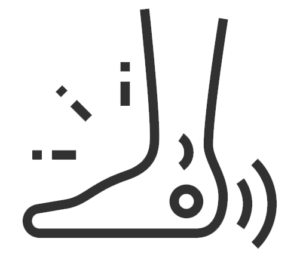Common Ankle & Feet Conditions we treat:



Acute & Chronic Ankle Sprains
Ankle sprains are one of the most common injuries we see. Did you know there are two types? One is an inversion sprain – or most commonly known as “rolling your ankle” which may happen from running on uneven ground or having a misstep.
The other type is an eversion sprain – a more severe sprain of the inside of your ankle. Both of these sprains refer to an injury to important ligaments in your ankle. Short term, you may experience pain with walking or with certain movements – bruising might even be present. One sprain may be minor, however once you have one, you may be more likely to experience another – in these cases it may develop into a chronic ankle sprain.
Imagine an elastic band – the more you stretch it beyond its limits, the more it loses its elasticity. This is similar to what happens in those with a chronic ankle sprain – their ligaments start losing its elasticity and tightness, leading to laxity or what is often described as feeling a little too “loose” in the joint.
Symptoms:
• Pain
• Swelling & brusing
• Short term decreased range of motion
• In cases of chronic ankle sprains – increased range of motion
• Feelings of clumsiness or unsteadiness while walking
When to see a Clinician:
If you recently rolled your ankle, are unable to weight bear and bruising is present, it may be time to have a second opinion on the status of your ankle. If you have a history of recurrent ankle sprains and are worried about the future, book an appointment with our physiotherapist or chiropractor who are both able to treat and rehabilitate your ankle so you can get back to doing what you love.
What treatment to Expect:
• We want to hear your story, how many ankle sprains you’ve experienced in the past
• A physical exam of your ankle will reveal the amount of “laxity” or “looseness” in the ankle
• Together, we will create a treatment plan that works around your schedule and needs
• This plan may include a mixture of deep muscle therapy, acupuncture joint mobilizations and prescriptive rehabilitation to have the ankle joint moving and feeling better.
Plantar Fasciitis
One of the more common conditions that contribute to foot pain. It is seen in many individuals who do a lot of standing, running, and/or walking but can be seen in sedentary individuals working from home who are not using foot support or on bare-feet all day. Plantar fasciitis can be mechanical in nature such as what is described above but can also be genetic as well. We see plantar fasciitis affecting people who have flat feet or overpronated feet (where the ankle rolls inwards).
Symptoms:
• Increased pain upon standing/walking/running and alleviates with rest
• Very local sharp or aching pain in the arch of the feet and sometimes the ball of the foot or calves
• The increase desire to try to massage underneath the foot after a long day
When to see a clinician?
Rest and ice plus a series of calf stretches can usually help quite a bit. Consider changing out of an old pair of shoes and into more comfortable running shoes. If pain persists for over 3 weeks after all these changes, seeing a chiropractor, physiotherapist, or registered massage therapist and considering a pair of custom orthotics could be very helpful.
What treatment should you expect?
• See how you walk, stand, and place pressure on your feet including a thorough check of your arches
• Deep/Soft Tissue Stretching and pressure to the calves and muscles underneath your feet
• Electroacupuncture and electrical stimulation in the surrounding areas may be considered
• Ultrasound therapy and custom foot orthotics will be considered
• Gradual rehab exercises including developing a stretching and strengthening protocol


